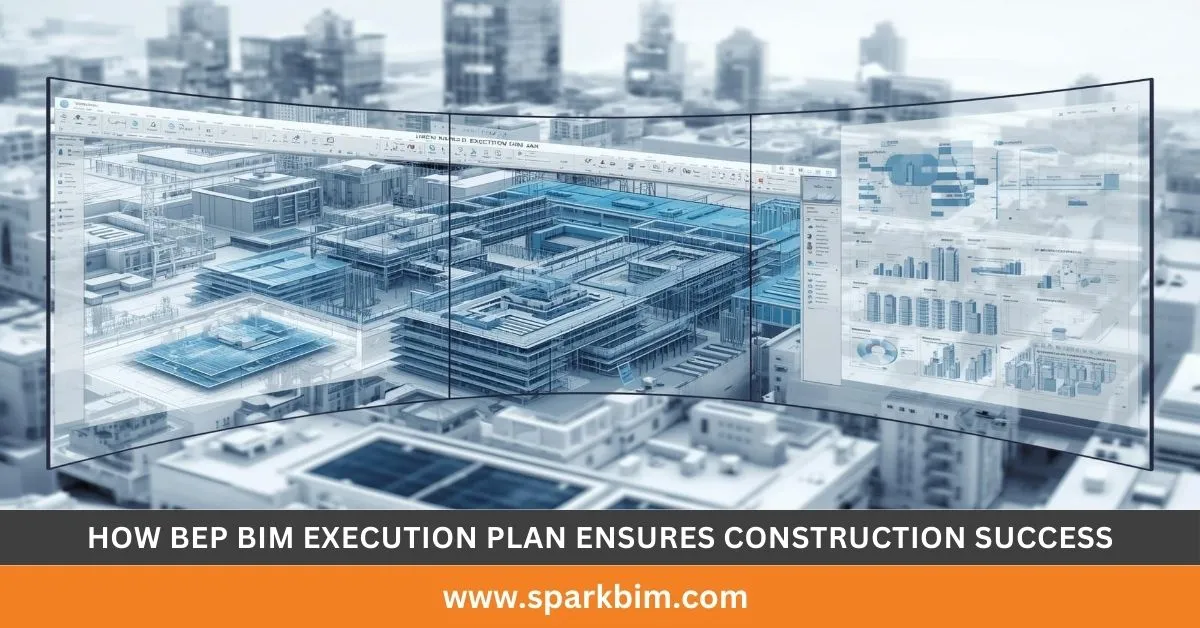Table of Contents
ToggleConstruction projects are no longer limited to simple drawings and on-site coordination. They now involve digital collaboration, strict deadlines, multiple teams, and high client expectations.
Managing all these moving parts without a proper roadmap can lead to delays, budget overruns, and conflicts. This is where the BEP BIM Execution Plan becomes essential. It acts like a project’s digital blueprint, showing how Building Information Modeling (BIM) will be used from start to finish.
With a structured BEP, stakeholders know their responsibilities, the tools they must use, and how to share data. This eliminates confusion and keeps everyone aligned toward project goals. The BEP meaning in BIM is simple: it ensures projects are efficient, cost-effective, and transparent.
In this blog post, we will explain what a BEP BIM Execution Plan is, why it matters, and how it ensures construction success in modern projects.
What Is BEP BIM Execution Plan?
A BEP BIM Execution Plan is a structured document that guides how BIM processes will be applied in a construction project. It is sometimes referred to as a Building Execution Plan or Project BIM Execution Plan.
The BEP answers important project questions such as who is responsible for which tasks, when specific activities will be carried out, and which tools or standards will be used.
The BIM execution plan definition makes it clear that the BEP is more than paperwork – it is a framework for achieving efficiency and consistency. For example, a BEP describes data exchange formats, roles of architects and contractors, model-sharing workflows, and quality assurance methods.
By doing so, it prevents confusion and ensures every stakeholder works toward the same objectives. Many firms also align their BEPs with the BIM execution plan ISO 19650 standards, which provide internationally recognized guidelines for BIM processes.
Why Is BEP Important in BIM
The BEP’s meaning in BIM goes far beyond being a simple guide. It is a strategy that ensures successful BIM adoption. Without a clear BEP, BIM risks turning into disconnected efforts with no coordination.
One of the key reasons the BEP is important is role clarity – every team member knows exactly what to deliver and when. This avoids duplication of work.
Secondly, it establishes consistency by making sure all teams follow the same naming conventions, formats, and workflows. Another advantage is efficiency – a proper BIM implementation plan reduces wasted effort and enables faster decision-making.
Furthermore, a BEP minimizes risks by detecting clashes early in the design stage, which avoids costly rework later.
Clients also benefit through transparency, as reports and updates are accurate. Companies that adopt a BIM Project Execution Plan consistently outperform those that rely on unstructured methods. In short, BEP makes BIM practical and successful.
Types of BEP in BIM
Two main types of BEPs play a critical role in construction.
1. Pre-Contract BIM Execution Plan
Pre-Contract BIM Execution Plan is prepared before signing a project contract. It helps contractors demonstrate their capabilities, resources, and approach to using BIM.
Clients often review this plan before selecting a contractor, making it an important part of winning projects.
2. Post-Contract BIM Execution Plan
Post-Contract BIM Execution Plan is also called the Project BIM Execution Plan. This is developed after the contract is awarded and includes much more detail. It defines team responsibilities, specific modeling workflows, and quality assurance methods. It is often referred to as the working document that guides the entire project delivery.
Together, these types ensure that BIM use is consistent from pre-contract discussions to actual project execution. Without them, even the best Project Implementation Plan BIM may fail to deliver value.
Core Elements of a BEP BIM Execution Plan
A strong BEP BIM Execution Plan Guide includes several important elements that keep projects structured and efficient. First, it defines project goals and objectives, which clarify what the client expects from BIM.
Examples include clash detection, 4D scheduling, or sustainability analysis. Next, it outlines project information, including scope, timelines, and milestones. The roles and responsibilities section assigns tasks to specific individuals or teams, ensuring accountability.
Standards and protocols are another critical part. Many firms align their BEP with ISO 19650 BIM execution plan requirements to ensure international consistency. The plan also describes collaboration procedures, including the use of a Common Data Environment (CDE) for model sharing and approvals.
Software and tools are identified, such as Revit BEP or BEP in Revit, ensuring everyone uses compatible platforms. Finally, it highlights quality control and auditing methods to maintain accuracy throughout the project lifecycle.
How BEP BIM Execution Plan Ensures Construction Success
A BEP BIM Execution Plan directly contributes to construction success in several ways.
First, it improves collaboration. With a detailed BEP in BIM, architects, engineers, and contractors all work using the same standards and tools, which eliminates miscommunication.
Second, it minimizes errors and reduces rework. By defining clash detection and review processes, issues are caught in the design stage rather than on-site, saving time and money.
Third, it increases efficiency and reduces costs. A clear BIM plan avoids duplication of work, ensures smooth workflows, and shortens project timelines.
Fourth, it ensures compliance with global standards, especially when aligned with the BIM execution plan ISO 19650.
Fifth, it supports better decision-making. Accurate and real-time data enables project managers to make quick, informed decisions.
Finally, it boosts client satisfaction, as a structured BIM execution plan for contractors makes progress more transparent and reliable. Together, these benefits guarantee construction success.
Step-by-Step BIM Project Execution Planning Guide
Creating a BIM project execution planning guide requires several structured steps.
Step-1: Define Project Goals
Identify client requirements and set measurable BIM uses, such as 3D coordination or 5D cost estimation.
Step-2: Assign Roles
Allocate responsibilities clearly. For example, architects may handle modeling, while contractors manage scheduling.
Step-3: Establish Standards
Follow global protocols like BIM execution plan ISO 19650 and ensure consistent file naming conventions.
Step-4: Choose Tools
Select compatible software such as Revit BEP or Navisworks.
Step-5: Develop Data Workflows
Use a Common Data Environment (CDE) for model sharing, reviews, and approvals.
Step-6: Implement Quality Checks
Perform audits, clash detection, and manual reviews at regular intervals.
Step-7: Monitor and Update
Treat the BEP as a living document that evolves as the project progresses.
BEP BIM Execution Plan in Real-World Construction
The value of a BEP BIM Execution Plan becomes clearer when applied to real projects. In one large commercial development, a contractor used a Project BIM Execution Plan to coordinate designs for a multi-story shopping mall.
Through clash detection and structured workflows, the team identified over 400 design conflicts before construction began. This proactive approach saved millions of dollars in potential rework and reduced project delays by three months.
Another case involved an infrastructure project, where a BIM Implementation Roadmap guided collaboration between government agencies and contractors. By following the BEP, the project achieved better design accuracy and reduced construction time by 15%.
These examples highlight that the BEP is not just a theoretical document but a practical tool. Whether it is a Pre-Contract BIM Execution Plan or a detailed Project Implementation Plan BIM, the results show clear cost savings, efficiency gains, and improved stakeholder confidence.
BEP in BIM and Revit
Many construction firms rely on Revit BEP because Revit is one of the most widely used BIM platforms in the industry.
A BEP in Revit provides guidelines for how models should be created, managed, and exchanged within the software environment. This includes naming conventions, parameter definitions, and model-sharing procedures.
For Example, when multiple architects and engineers work on different parts of a building, the BEP ensures that every Revit model follows the same structure.
This consistency makes it easier to combine models, detect clashes, and generate reports. It also ensures that subcontractors, consultants, and contractors can seamlessly collaborate without compatibility issues.
In addition, using a BEP in Revit streamlines project handover because the digital models are consistent and reliable. In short, integrating a BEP with Revit is one of the most effective ways to achieve smooth workflows, minimize confusion, and maximize the benefits of BIM.
BEP BIM Execution Plan and Contractors
Contractors often gain the most from a well-prepared BIM Execution Plan for Contractors. In construction, delays and cost overruns can severely impact profitability.
A BEP BIM Execution Plan helps contractors avoid these risks by defining clear workflows, data exchange methods, and scheduling processes.
For Example, contractors can use 4D scheduling, which links the project timeline with the BIM model, to plan site activities in detail.
The BEP also supports accurate cost estimation and quantity take-offs, reducing material waste. Safety is another area where the BEP adds value. By digitally rehearsing construction activities, contractors can identify potential safety hazards before work begins.
Moreover, clear communication with subcontractors through a Building Execution Plan ensures that tasks are properly coordinated. In essence, the BEP gives contractors a roadmap that improves productivity, reduces uncertainty, and enhances project delivery. For today’s competitive industry, having a BEP is no longer optional – it is a necessity.
Future of BEP in BIM
The future of the BEP BIM Execution Plan is closely tied to technological advancements. As construction adopts digital twins, artificial intelligence (AI), and the Internet of Things (IoT), BEPs will evolve into smarter and more dynamic tools.
Instead of being static documents, future BEPs will be digital platforms that automatically update based on real-time project data. For example, sensors on-site can feed progress data into the BEP, updating schedules and resource plans instantly.
AI-driven clash detection will further reduce manual effort, while predictive analytics will help project managers anticipate risks before they occur.
Companies adopting a BIM Implementation Plan for the Company will also integrate sustainability goals, ensuring greener and more efficient projects. Standards like ISO 19650 BIM execution plan will continue to shape global best practices.
In short, the BEP is moving from being a planning guide to becoming an intelligent project management system that drives construction success.
Conclusion
The BEP BIM Execution Plan is not just a supporting document – it is the backbone of modern construction project success. It ensures collaboration, eliminates confusion, reduces errors, and improves efficiency.
From Pre-Contract BIM Execution Plans that demonstrate contractor capabilities to detailed Project BIM Execution Plans that guide daily operations, BEPs play a crucial role in achieving client satisfaction.
Contractors, architects, and engineers all benefit from the clarity and structure provided by a BEP. Whether integrated into tools like Revit BEP or aligned with international standards such as the BIM execution plan ISO 19650, the BEP ensures consistency and compliance.
As the industry adopts advanced technologies, BEPs will become smarter and more automated, offering real-time updates and predictive insights.
For any company seeking long-term success in construction, adopting a strong BEP BIM Execution Plan is no longer a choice – it is an essential step toward efficiency, quality, and innovation.


